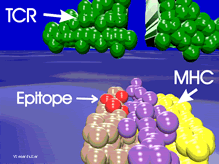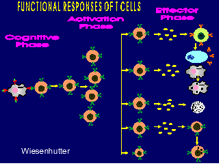U.C.L.A. Rheumatology Pathophysiology of Disease Course Lecture,
Second Year Medical School 1997
Rheumatoid Arthritis Page 14
damage. They are the predominant lymphocyte population in the proliferative synovium and they release cytokines which amplify and perpetuate inflammation in the joints and activate B cells (figure 5). They are believed to be activated through the RA-related MHC Class II epitope described above in combination with a disease-provoking antigenic peptide or with a super-antigen that binds to the MHC. The pathogenic sets of T cells are suspected to share certain common T cell receptors.

